     
|
Pont-de-Montvert, stage of the GR®70 Stevenson Trail
|
     
|
Pont-de-Montvert is a major and historically rich stop on the GR 70, the Stevenson Trail, located in the Lozère department. This picturesque village is beautifully traversed by the tumultuous waters of the nascent Tarn, crossed by a medieval granite bridge that gives the locality its name. The writer Robert Louis Stevenson stopped here in 1878 with his donkey Modestine, immortalizing the place in his travel narrative through the Cévennes.

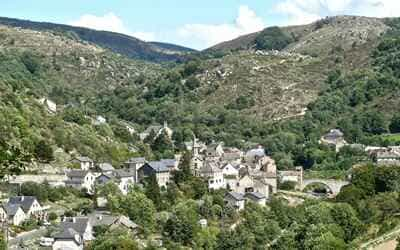 Afternoon... Without haste, after having descended a delicate valley and jumped over a bubbling stream, we approach the Pont-de-Montvert, an almost seaside village perched above the Tarn. The heart slows after the effort, and the cheerful sun chases away the clouds. Here, in Camisard country, the summer mood conquers the memory of the religious wars. Here, those who were called the fools of God put an end to the life and actions of Abbot Chayla, a furious and cruel Catholic priest. In his house by the bridge, the abbot imprisoned the recalcitrant Protestants who refused to abjure. Abraham Mazel, a prophet inspired by the Bible and divine word, became the scribe of heavenly vengeance.
Afternoon... Without haste, after having descended a delicate valley and jumped over a bubbling stream, we approach the Pont-de-Montvert, an almost seaside village perched above the Tarn. The heart slows after the effort, and the cheerful sun chases away the clouds. Here, in Camisard country, the summer mood conquers the memory of the religious wars. Here, those who were called the fools of God put an end to the life and actions of Abbot Chayla, a furious and cruel Catholic priest. In his house by the bridge, the abbot imprisoned the recalcitrant Protestants who refused to abjure. Abraham Mazel, a prophet inspired by the Bible and divine word, became the scribe of heavenly vengeance.
With Laporte, Esprit Seguier, Salamon Couderc, Jean Rampon, and Nicolas Joini - nicknamed the leaders of the spirit - he became the vengeful arm on July 24, 1702. After demanding that the abbot release the imprisoned brothers, they burned the house and captured the old man.
Abbot Chayla refused to pray for his forgiveness and perished under the sword of Esprit Seguier. He struck him on the head, and Joini imitated him. According to the inspired, the Lord had demanded it.
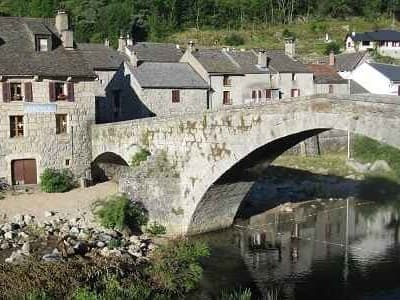 Behind the abbot, the Camisards fought against Louis XIV and the revocation of the Edict of Nantes, armed only with swords, flames, and prophecies. All their missions were commanded by the divine spirit. For four days, the Protestant troops burned churches and castles, responded tooth for tooth to the humiliations, and assassinated two clerics along the way. The cup was full. Too many temples destroyed, absurd tortures, and believers in galleys...
Behind the abbot, the Camisards fought against Louis XIV and the revocation of the Edict of Nantes, armed only with swords, flames, and prophecies. All their missions were commanded by the divine spirit. For four days, the Protestant troops burned churches and castles, responded tooth for tooth to the humiliations, and assassinated two clerics along the way. The cup was full. Too many temples destroyed, absurd tortures, and believers in galleys...
Four days after the murder of the abbot, Esprit Seguier was arrested at Plant de Fontmort by the king's armies, judged in Florac, and executed at the foot of the clock tower of the Pont-de-Montvert, where the abbot had died. Abraham Mazel recounts in his memoirs the exceptional courage of Seguier. They severed his hand; he extended the other. It is said that he even tore the flesh hanging from his wrist with his teeth. As they lit the pyre, he began to sing. Nothing could silence him, neither the flames nor the fear of hell. In a final breath, Esprit Seguier predicted that the place where he was dying would be carried away by the waters. Mazel tells that shortly after, the Tarn boiled, overflowed its banks, and carried away the said place...
For two years, the Camisards withdrew to the desert, the name given to their places of worship in nature. They sometimes managed to hold the king's armies at bay, in a struggle where, following Esprit, Seguier, other leaders would also distinguish themselves: Roland, Cavalier, warriors of God with unwavering zeal and exemplary faith...
When the clock tower and the bridge appear in the summer light, one believes they see the bridge of Mostar, the Ottoman Mostar, bombed and destroyed by the Croats - where even the Serbs refrained.
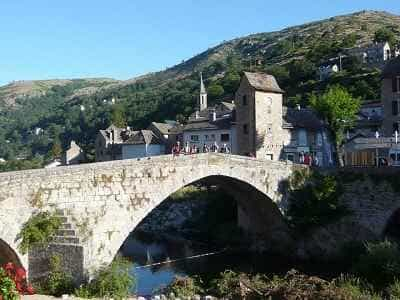 In November 1993, the Stari Most, a Turkish construction from the 17th century, known as "the old one" by the Croatian, Muslim, and Serbian populations who had resisted invasions, earthquakes, and years, breathed its last after two days of bombardments. The war split the most mixed and tolerant city in Herzegovina in two. People drank tea in the souks and jumped from the old bridge.
In November 1993, the Stari Most, a Turkish construction from the 17th century, known as "the old one" by the Croatian, Muslim, and Serbian populations who had resisted invasions, earthquakes, and years, breathed its last after two days of bombardments. The war split the most mixed and tolerant city in Herzegovina in two. People drank tea in the souks and jumped from the old bridge.
At the library or on the terraces of the cafés, people read Danilo Kis and Ivo Andric, two unbelieving poets, skeptical of the "trains of history." Danilo Kis critiques the ruling ideologies and "princes." Before him, Ivo Andric had dreamed of a city of tolerance and a bridge as a passage from East to West. The bridge over the Drina tells the prophetic story of this tolerance. From now on, Mostar is a symbol of absurdity and suffering, and the Neretva, the "world," flows and weeps. And people mourn their bridge. Parked in the East, on the left bank, Muslims remember before the war. Before the bombs, before the piled bodies. When it didn’t matter who was Muslim and who was Croatian. In the empty streets, children play soldiers among the ruins, indifferent, scornful of war.
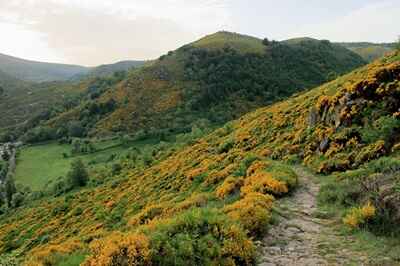 The old town is almost destroyed. The alleys, the bazaar, the cafés, the mosque, theaters, the library, and the bridge have disappeared. My Berber brother, Mohamed Grim, taught me to share bread and salt in a spirit of tolerance, mutual respect, and exemplary brotherhood. With Fehrat the Kabyle, they sing... penetrate my heart: it was my childhood / it was the war. "At the Pont-de-Montvert, there is sunshine and believers who talk to each other. In Mostar, the city, champion of destruction, heals its wounds. The soul of the city has fled along the Neretva. Far from the arches of the old bridge...
The old town is almost destroyed. The alleys, the bazaar, the cafés, the mosque, theaters, the library, and the bridge have disappeared. My Berber brother, Mohamed Grim, taught me to share bread and salt in a spirit of tolerance, mutual respect, and exemplary brotherhood. With Fehrat the Kabyle, they sing... penetrate my heart: it was my childhood / it was the war. "At the Pont-de-Montvert, there is sunshine and believers who talk to each other. In Mostar, the city, champion of destruction, heals its wounds. The soul of the city has fled along the Neretva. Far from the arches of the old bridge...
At the Pont-de-Montvert, the vaults are less impressive than in Mostar. Yet the bridges seem like twins: the same volute, the same texture - the bridges have a voice - the same elegance... In the village that connects two valleys, it is quite impossible on this late afternoon to imagine the king's dragons and the religious repressions. The sweetness of living and praying in peace has long since reclaimed its rightful place.
Catholics and Protestants marry each other. On Sunday morning, everyone returns to their place of worship. Half of the population is at the temple, the other half at the church, and the rest are scattered in the two bistros of the village. After the service, the worshippers join the family table for festive Sunday meals. As the sun declines, the sparkling Tarn winds through the valley and vocalizes. The protective cliffs that enclose the delicate village today make it the most pleasant of stops.
The Stevenson Trail crosses the entire village. It is raining. The Tarn rises and rumbles. I learn the meaning of the word "torrential." The waters swirl and roar. The mountain spews furious torrents. The clouds dictate the law. Under the waters, the bridge regains its appearance as an isolated village. The doors close. In the café, customers talk about mushrooms - "with weather like this, they won't have trouble breaking through the ground" - and yesterday's hunt. Zinc conversations... They comment on the story of a guy who killed a horse, thinking it was a duck; and another who shot his buddy hiding in a thicket, convinced he was face to face with a wild boar.
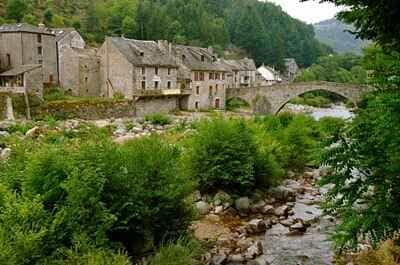 To conclude, we console ourselves: - One must not complain, last year, at the same time, it was snowing. Since this year it is only the universal deluge, let’s toast to our misfortunes before the excursion into the flooded village. We had been warned: The Pont-de-Montvert is a stop. The Lozère is dying. The merchants and villagers lament. In summer, it’s almost the Côte d'Azur; in winter, it’s Siberia. It’s the waitress who says so.
To conclude, we console ourselves: - One must not complain, last year, at the same time, it was snowing. Since this year it is only the universal deluge, let’s toast to our misfortunes before the excursion into the flooded village. We had been warned: The Pont-de-Montvert is a stop. The Lozère is dying. The merchants and villagers lament. In summer, it’s almost the Côte d'Azur; in winter, it’s Siberia. It’s the waitress who says so.
The house of Abbot Chayla...
It could be any building; moreover, the inhabitants of the bridge enjoy deceiving visitors by showing them a different facade each time. The residents of Montvert improvise as guides and lecturers... Gullible tourists, dressed like Breton sailors, have always loved stones with dates. Here, the house of Chayla is of little importance and can be overlooked. Furthermore, it no longer exists; history has erased the cruelties of the past. The cursed house where two years of massacre began is a bad memory. It encroached upon the sidewalk and hindered automobile traffic, so it has been replaced by an anonymous building that knows how to give way to all-terrain vehicles on hunting days and convertibles on tourist days. Only the cellar and the garden remain, where cabbages and large salads thrive. A vegetable garden replaces the original terrace where the horrible priest fell. A pumpkin is growing in this spot.
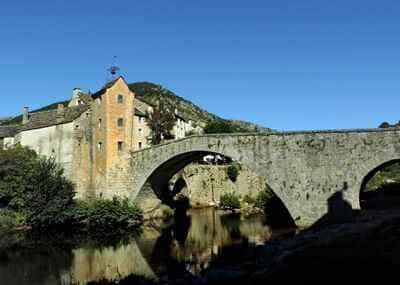 The temple, at nightfall.
The temple, at nightfall.
Stevenson notices the temple upon his arrival but does not specify whether he visited it. It was, however, one of the stated reasons for the trip. He wanted to meet the Protestants, whom he compares to the Scottish covenantarians—Presbyterians who oppose Catholic and Anglican obligations.
From the Pont-de-Montvert, Stevenson begins to trace History. He has brought along The Fathers of the Desert by Napoléon Peyrat, books by Michelet, and various stories. Studious, he notes, compiles, revisits the texts, and arranges them in his own way, not hesitating to copy some inaccuracies.
When he arrives in Florac, what he calls the Cévennes of the Cévennes, he forgets the journey and begins to recount the religious wars. In ignorance and doubt, I hardly follow him in this territory. The history of the Camisards is a matter for scholarly analyses, and those who wish to learn more about the inspired or the prophets of the desert can today read the works of Philippe Joutard. As the son of a Scottish Presbyterian, Robert Louis Stevenson is not a historian. He tells in his beautiful, romantic, and flamboyant style. A strange and almost lyrical emotion grips the reader as he recounts the interrogation of Esprit Seguier. The writer addresses his reader:
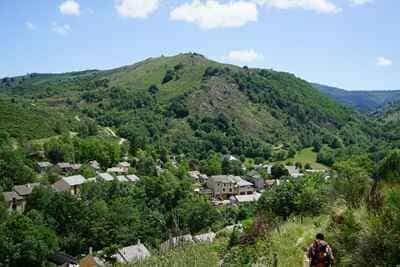 And perhaps if you could read in myself and if I could read in your conscience, our mutual calmness would be less surprising. Stevenson presents the character of Seguier as in a novel, describing a proud and inspired hero who defies the Catholic Church, its dogmas, and its violence one last time. He lets us listen to the last words before the death sentence:
And perhaps if you could read in myself and if I could read in your conscience, our mutual calmness would be less surprising. Stevenson presents the character of Seguier as in a novel, describing a proud and inspired hero who defies the Catholic Church, its dogmas, and its violence one last time. He lets us listen to the last words before the death sentence:
- Your name?
- Pierre Seguier.
- Why are you called Esprit?
- Because the Spirit of the Lord dwells in me.
- Your residence?
- Ultimately the desert and, soon, heaven.
- Do you not have remorse for your crimes?
- I have committed none. My soul resembles a garden full of pavilions and fountains.
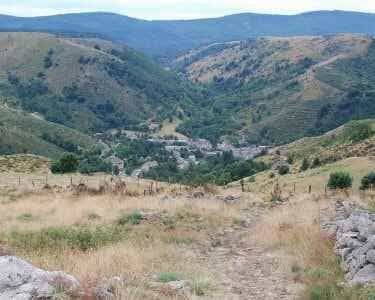 Seguier, Stevenson specifies, believed he was at the right hand of God. Unlike the Scottish covenantarians who had dealings with the devil, Stevenson considers the French Protestants as believers with a clear conscience, despite the blood. To support his claims, he notes the testimony of an old camisard... "We ran when we heard the singing of the psalms, we ran as if we had wings. We felt, in our innermost being, an exhilarating ardor, a desire that lifted us." Words cannot translate our feelings. Stevenson seems to share the faith of the witness. The camisard continues: "It is something one must have felt to understand it. As exhausted as we might have been, we no longer thought of our fatigue, and we became enthusiastic as soon as the singing of the psalms reached our ears."
Seguier, Stevenson specifies, believed he was at the right hand of God. Unlike the Scottish covenantarians who had dealings with the devil, Stevenson considers the French Protestants as believers with a clear conscience, despite the blood. To support his claims, he notes the testimony of an old camisard... "We ran when we heard the singing of the psalms, we ran as if we had wings. We felt, in our innermost being, an exhilarating ardor, a desire that lifted us." Words cannot translate our feelings. Stevenson seems to share the faith of the witness. The camisard continues: "It is something one must have felt to understand it. As exhausted as we might have been, we no longer thought of our fatigue, and we became enthusiastic as soon as the singing of the psalms reached our ears."
In my turn, in the empty, white temple, I hear the psalms. I am alone. In the silence and exemplary sobriety, I see again the Huguenot cross worn by the mother of my children. A Catholic and a Protestant. Waiting for baptism, our children will make their choice. The soul like "a garden filled with pavilions and fountains." I am not a historian, barely a poet. In lieu of being Protestant, I am penitent. "The rock is hard as blood / The believers have the souls of wrestlers."
Later, on the road, Stevenson will confide in his book: I admit having met these Protestants with pleasure and with the impression of being among family. The silent temple seems to whisper the same words. Anyone can enter, enjoy the refuge, and listen. Bold companions, listen to the songs of old, sing with all your might and meditate despite the cold. Pray together. The gods have given you a heart. This is my prayer. Tomorrow, in the heart of the woods, we will be in the desert. The caves, the woods, and the fields, the shores and the beds of the waterways will serve my prayer. Believing in Esprit Seguier and practicing Saint Joseph Delteil, I will address anyone who wishes to hear me. by Eric Poindron. Excerpt from "Beautiful Stars" with Stevenson in the Cévennes, Gulliver collection, directed by Michel Le Bris, Flammarion.
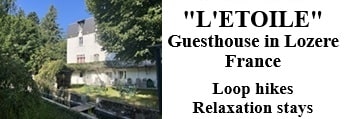
Former holiday hotel with a garden along the Allier, L'Etoile Guest House is located in La Bastide-Puylaurent between Lozere, Ardeche, and the Cevennes in the mountains of Southern France. At the crossroads of GR®7, GR®70 Stevenson Path, GR®72, GR®700 Regordane Way, GR®470 Allier River springs and gorges, GRP® Cevenol, Ardechoise Mountains, Margeride. Numerous loop trails for hiking and one-day biking excursions. Ideal for a relaxing and hiking getaway.
Copyright©etoile.fr

 Afternoon... Without haste, after having descended a delicate valley and jumped over a bubbling stream, we approach the Pont-de-Montvert, an almost seaside village perched above the Tarn. The heart slows after the effort, and the cheerful sun chases away the clouds. Here, in Camisard country, the summer mood conquers the memory of the religious wars. Here, those who were called the fools of God put an end to the life and actions of Abbot Chayla, a furious and cruel Catholic priest. In his house by the bridge, the abbot imprisoned the recalcitrant Protestants who refused to abjure. Abraham Mazel, a prophet inspired by the Bible and divine word, became the scribe of heavenly vengeance.
Afternoon... Without haste, after having descended a delicate valley and jumped over a bubbling stream, we approach the Pont-de-Montvert, an almost seaside village perched above the Tarn. The heart slows after the effort, and the cheerful sun chases away the clouds. Here, in Camisard country, the summer mood conquers the memory of the religious wars. Here, those who were called the fools of God put an end to the life and actions of Abbot Chayla, a furious and cruel Catholic priest. In his house by the bridge, the abbot imprisoned the recalcitrant Protestants who refused to abjure. Abraham Mazel, a prophet inspired by the Bible and divine word, became the scribe of heavenly vengeance. Behind the abbot, the Camisards fought against Louis XIV and the revocation of the Edict of Nantes, armed only with swords, flames, and prophecies. All their missions were commanded by the divine spirit. For four days, the Protestant troops burned churches and castles, responded tooth for tooth to the humiliations, and assassinated two clerics along the way. The cup was full. Too many temples destroyed, absurd tortures, and believers in galleys...
Behind the abbot, the Camisards fought against Louis XIV and the revocation of the Edict of Nantes, armed only with swords, flames, and prophecies. All their missions were commanded by the divine spirit. For four days, the Protestant troops burned churches and castles, responded tooth for tooth to the humiliations, and assassinated two clerics along the way. The cup was full. Too many temples destroyed, absurd tortures, and believers in galleys... In November 1993, the Stari Most, a Turkish construction from the 17th century, known as "the old one" by the Croatian, Muslim, and Serbian populations who had resisted invasions, earthquakes, and years, breathed its last after two days of bombardments. The war split the most mixed and tolerant city in Herzegovina in two. People drank tea in the souks and jumped from the old bridge.
In November 1993, the Stari Most, a Turkish construction from the 17th century, known as "the old one" by the Croatian, Muslim, and Serbian populations who had resisted invasions, earthquakes, and years, breathed its last after two days of bombardments. The war split the most mixed and tolerant city in Herzegovina in two. People drank tea in the souks and jumped from the old bridge. The old town is almost destroyed. The alleys, the bazaar, the cafés, the mosque, theaters, the library, and the bridge have disappeared. My Berber brother, Mohamed Grim, taught me to share bread and salt in a spirit of tolerance, mutual respect, and exemplary brotherhood. With Fehrat the Kabyle, they sing... penetrate my heart: it was my childhood / it was the war. "At the Pont-de-Montvert, there is sunshine and believers who talk to each other. In Mostar, the city, champion of destruction, heals its wounds. The soul of the city has fled along the Neretva. Far from the arches of the old bridge...
The old town is almost destroyed. The alleys, the bazaar, the cafés, the mosque, theaters, the library, and the bridge have disappeared. My Berber brother, Mohamed Grim, taught me to share bread and salt in a spirit of tolerance, mutual respect, and exemplary brotherhood. With Fehrat the Kabyle, they sing... penetrate my heart: it was my childhood / it was the war. "At the Pont-de-Montvert, there is sunshine and believers who talk to each other. In Mostar, the city, champion of destruction, heals its wounds. The soul of the city has fled along the Neretva. Far from the arches of the old bridge... To conclude, we console ourselves: - One must not complain, last year, at the same time, it was snowing. Since this year it is only the universal deluge, let’s toast to our misfortunes before the excursion into the flooded village. We had been warned: The Pont-de-Montvert is a stop. The Lozère is dying. The merchants and villagers lament. In summer, it’s almost the Côte d'Azur; in winter, it’s Siberia. It’s the waitress who says so.
To conclude, we console ourselves: - One must not complain, last year, at the same time, it was snowing. Since this year it is only the universal deluge, let’s toast to our misfortunes before the excursion into the flooded village. We had been warned: The Pont-de-Montvert is a stop. The Lozère is dying. The merchants and villagers lament. In summer, it’s almost the Côte d'Azur; in winter, it’s Siberia. It’s the waitress who says so. The temple, at nightfall.
The temple, at nightfall. And perhaps if you could read in myself and if I could read in your conscience, our mutual calmness would be less surprising. Stevenson presents the character of Seguier as in a novel, describing a proud and inspired hero who defies the Catholic Church, its dogmas, and its violence one last time. He lets us listen to the last words before the death sentence:
And perhaps if you could read in myself and if I could read in your conscience, our mutual calmness would be less surprising. Stevenson presents the character of Seguier as in a novel, describing a proud and inspired hero who defies the Catholic Church, its dogmas, and its violence one last time. He lets us listen to the last words before the death sentence:
 Seguier, Stevenson specifies, believed he was at the right hand of God. Unlike the Scottish covenantarians who had dealings with the devil, Stevenson considers the French Protestants as believers with a clear conscience, despite the blood. To support his claims, he notes the testimony of an old camisard... "We ran when we heard the singing of the psalms, we ran as if we had wings. We felt, in our innermost being, an exhilarating ardor, a desire that lifted us." Words cannot translate our feelings. Stevenson seems to share the faith of the witness. The camisard continues: "It is something one must have felt to understand it. As exhausted as we might have been, we no longer thought of our fatigue, and we became enthusiastic as soon as the singing of the psalms reached our ears."
Seguier, Stevenson specifies, believed he was at the right hand of God. Unlike the Scottish covenantarians who had dealings with the devil, Stevenson considers the French Protestants as believers with a clear conscience, despite the blood. To support his claims, he notes the testimony of an old camisard... "We ran when we heard the singing of the psalms, we ran as if we had wings. We felt, in our innermost being, an exhilarating ardor, a desire that lifted us." Words cannot translate our feelings. Stevenson seems to share the faith of the witness. The camisard continues: "It is something one must have felt to understand it. As exhausted as we might have been, we no longer thought of our fatigue, and we became enthusiastic as soon as the singing of the psalms reached our ears."